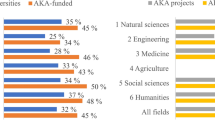Abstract
This research aims to investigate the effect of the Derek de Solla Price memorial award reception on publishing behavior of medalists through comparing their research performance in 5 years before and after the prize. The current study was conducted using scientometric indicators. The population of the study was comprised of all scholarly output of 26 Price medalists. Web of Science and Journal Citation Reports were utilized for data collection. Results of the study revealed that the research performance of medalists in all five studied indicators, namely the number of publications, the number of citations received, the quality of journals in which their articles have been published, the number of research collaborations and the number of research collaborators, improved after prize reception, but not in a statistically significant level. Moreover, the tendency of prize winners to international research collaboration has increased in a notable manner upon prize reception. We can conclude that he reception of Price medal in scientometrics has no statistically significant effect on the medalists’ scientific publication, citation impact and research collaboration patterns.





Similar content being viewed by others
References
Borjas GJ, Doran KB. Prizes and productivity how winning the fields medal affects scientific output. J Hum Resour. 2015;50(3):728–58.
Chan HF, Önder AS, Torgler B. Do Nobel laureates change their patterns of collaboration following prize reception? Scientometrics. 2015;105(3):2215–35.
Frandsen TF, Nicolaisen J. The ripple effect: citation chain reactions of a nobel prize. J Am Soc Inform Sci Technol. 2013;64(3):437–47.
Garfield E. From the science of science to Scientometrics visualizing the history of science with HistCite software. J Informetr. 2009;3(3):173–9.
Gingras Y, Wallace M. Why it has become more difficult to predict Nobel Prize winners: a bibliometric analysis of nominees and winners of the chemistry and physics prizes (1901–2007). Scientometrics. 2009;82(2):401–12.
Glänzel W, Persson O. H-index for Price medalists. ISSI newsletter. 2005;1(4):15–8.
Hugget S. Does a Nobel Prize lead to more citations. Res Trends. 2010;20:5–6.
Kademani BS, Kalyane VL, Kumar V, Mohan L. Nobel laureates: their publication productivity, collaboration and authorship status. Scientometrics. 2005;62(2):261–8.
Levitt J, Thelwall M (2014) Investigating the impact of the award of the Nobel Prize on tweets. In: Proceedings of the science and technology indicators conference, Leiden, Netherlands, September 2014.
Ma C, Su C, Yuan J, Wu Y. Papers written by Nobel Prize winners in physics before they won the prize: an analysis of their language and journal of publication. Scientometrics. 2012;93(3):1151–63.
Mazloumian A, Eom YH, Helbing D, Lozano S, Fortunato S. How citation boosts promote scientific paradigm shifts and nobel prizes. PLoS ONE. 2011;6(5):e18975.
de Solla PDJ. Little science, big science. New York: Columbia University Press; 1963.
de Solla PDJ. Networks of scientific papers. Science. 1965;149:510–5.
de Solla PDJ. A general theory of bibliometric and other cumulative advantage processes. J Am Soc Inf Sci. 1976;27:292–306.
Vanclay JK. Publication patterns of award-winning forest scientists and implications for the Australian ERA journal ranking. J Informetr. 2012;6(1):19–26.
Wagner CS, Horlings E, Whetsell TA, Mattsson P, Nordqvist K. Do Nobel Laureates create prize-winning networks? An analysis of collaborative research in physiology or medicine. PLoS ONE. 2015;10(7):e0134164.
Zheng J, Liu N. Mapping of important international academic awards. Scientometrics. 2015;104(3):763–91.
Zuckerman H. Nobel laureates in science: patterns of productivity, collaboration, and authorship. Am Sociol Rev. 1967;32(3):391–403.
Zuckerman H. Scientific elite: Nobel laureates in the United States. Piscataway: Transaction Publishers; 1977.
Author information
Authors and Affiliations
Corresponding author
Additional information
Publisher's Note
Springer Nature remains neutral with regard to jurisdictional claims in published maps and institutional affiliations.
Rights and permissions
About this article
Cite this article
Erfanmanesh, M., Moghiseh, Z. How Winning an International Scientific Award Affects Publishing Behavior of Laureates: the Case of Derek de Solla Price Medal in Scientometrics. Pub Res Q 35, 201–212 (2019). https://doi.org/10.1007/s12109-018-9619-7
Published:
Issue Date:
DOI: https://doi.org/10.1007/s12109-018-9619-7




